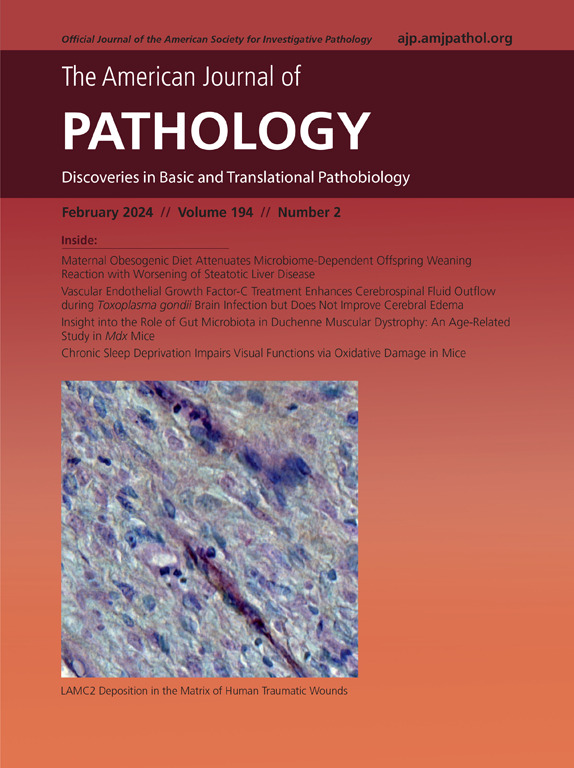Ablation of CD44 Attenuates Adipogenesis in White Adipocytes via the Tryptophan 5-Hydroxylase 2/5-Hydroxytryptamine Axis to Protect Mice from High-Fat Diet–Induced Obesity
IF 3.6
2区 医学
Q1 PATHOLOGY
引用次数: 0
Abstract
CD44 is a transmembrane protein that plays an essential role in transducing extracellular stimuli into intracellular signaling cascades, especially in cancer cells. Recent studies have shown that CD44 contributes to metabolic regulation. However, the effect of CD44 on adipogenesis in white adipose tissue (WAT) remains unclear. Herein, the expression of CD44 was largely increased in the inguinal and epididymal WAT of obese mice. Ablation or neutralization of CD44 inhibited adipogenesis in cultured adipocytes. CD44-deficient mice were resistant to high-fat diet–induced obesity and metabolic dysfunction. RNA-sequencing, together with functional studies, revealed that reduced expression of tryptophan 5-hydroxylase 2 (Tph2) in WAT was responsible for the repressed adipogenesis in the absence of CD44. The application of 5-hydroxytryptamine, a product of TPH2, rescued the repressed adipogenesis induced by CD44 neutralization. Moreover, the inhibition of TPH2 by p-chlorophenylalanine recapitulated the beneficial phenotypes observed in CD44-deficient mice. Taken together, these data indicate that CD44 plays a pivotal role in adipogenesis in WAT. In this regard, CD44 and its downstream target TPH2 may hold great therapeutic potential for treating excessive adiposity-related metabolic disorders, such as obesity, insulin resistance, and type 2 diabetes.

通过 TPH2/5-HT 轴消减 CD44 可减轻白色脂肪细胞的脂肪生成,从而保护小鼠免受高脂饮食诱发的肥胖症。
CD44 是一种跨膜蛋白,在将细胞外刺激转化为细胞内信号级联方面发挥着重要作用,尤其是在癌细胞中。最近的研究表明,CD44 有助于新陈代谢的调节。然而,CD44对白色脂肪组织(WAT)脂肪生成的影响仍不清楚。这里的研究结果表明,CD44在肥胖小鼠腹股沟和附睾WAT中的表达大量增加。CD44的消融或中和抑制了培养脂肪细胞的脂肪生成。CD44缺陷小鼠对高脂饮食(HFD)诱导的肥胖和代谢功能障碍有抵抗力。RNA-seq和功能研究发现,色氨酸5-羟化酶2(Tph2)在WAT中的表达减少是CD44缺失时脂肪生成受抑制的原因。应用 5- 羟色胺(5-HT)(TPH2 的一种产物)可挽救 CD44 中和诱导的抑制性脂肪生成。此外,对氯苯丙氨酸(pCPA)对 TPH2 的抑制再现了在 CD44 缺失小鼠中观察到的有益表型。总之,这些数据表明,CD44 在 WAT 的脂肪生成过程中起着关键作用。因此,CD44 及其下游靶标 TPH2 在治疗肥胖、胰岛素抵抗和 2 型糖尿病等与脂肪过多有关的代谢疾病方面具有巨大的治疗潜力。
本文章由计算机程序翻译,如有差异,请以英文原文为准。
求助全文
约1分钟内获得全文
求助全文
来源期刊
CiteScore
11.40
自引率
0.00%
发文量
178
审稿时长
30 days
期刊介绍:
The American Journal of Pathology, official journal of the American Society for Investigative Pathology, published by Elsevier, Inc., seeks high-quality original research reports, reviews, and commentaries related to the molecular and cellular basis of disease. The editors will consider basic, translational, and clinical investigations that directly address mechanisms of pathogenesis or provide a foundation for future mechanistic inquiries. Examples of such foundational investigations include data mining, identification of biomarkers, molecular pathology, and discovery research. Foundational studies that incorporate deep learning and artificial intelligence are also welcome. High priority is given to studies of human disease and relevant experimental models using molecular, cellular, and organismal approaches.

 求助内容:
求助内容: 应助结果提醒方式:
应助结果提醒方式:


